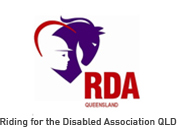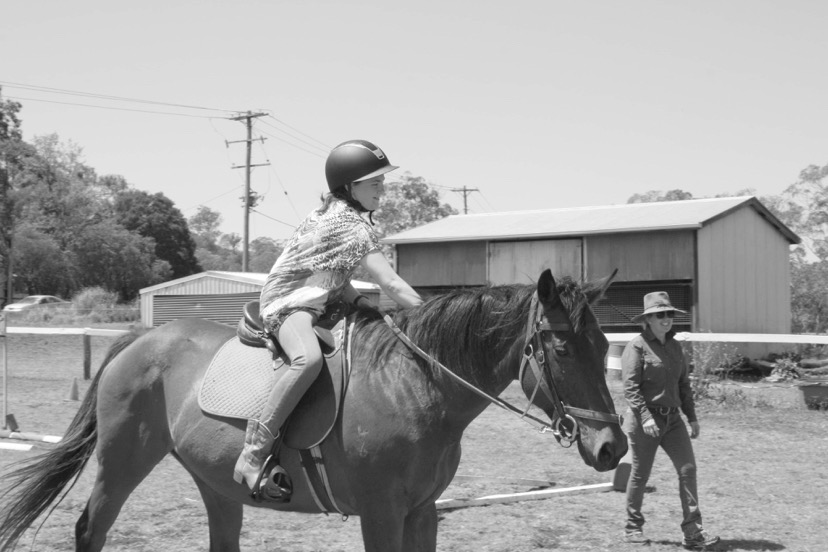Our programs make a huge difference to the lives of children and adults with special needs and disabilities.
Who We Help
People with all types and levels of disability are accepted into RDA programs (including but not limited to):
• Attention Deficit Disorder
• Autism Spectrum Disorder
• Cerebral Palsy
• Down Syndrome
• Epilepsy
• Hearing Impairment
• Multiple Sclerosis
• Muscular Dystrophy
• Spina Bifida
• Vision Impairment
• Psychological disabilities
How our programs help.
Animals often create a special bond with humans and this is especially true with horses. The nonverbal communication between the person and the horse strengthens the emotional bond that is created. Words aren’t needed for them to be perfectly in tune with each other. Emotions find space to flow and the relationship between them creates a love and understanding that is often indescribable.
Horse riding is a natural reflex inhibiting position which helps improve balance and posture providing a unique form of exercise and rehabilitation.
PHYSICAL BENEFITS
Improved Balance
As the horse moves the rider is constantly thrown off balance, requiring the rider’s muscles to contract and relax in an attempt to rebalance. This exercising is similar to physiotherapy, reaching the deep muscles, but making the therapy more enjoyable and even fun!
The three-dimensional rhythmic movement of the horse is similar to the motion of walking, teaching rhythmical patterns to the muscles of the legs and trunk. By placing the rider in different positions on the horse (therapeutic riding) different muscles are worked. Stopping and starting the horse as well as changing the speed and direction increases the benefits.
Strengthened Muscles
Muscles are strengthened by the increased use involved in riding. Even though riding is exercise, it is perceived as enjoyment, therefore the rider has increased tolerance and motivation to lengthen the period of exercise.
Improved Coordination, Faster Reflexes and Better Motor Planning
Riding a horse requires a great deal of coordination in order to get the desired response from the horse. Since the horse provides instant feedback to every action from the rider, it is easy to know when you have given the correct cue. Repetition of the patterned movements required in controlling a horse quickens the reflexes and aids in motor planning.
Stretching of Tight or Spastic Muscles
Sitting on a horse requires stretching of the adductor muscles of the thighs. This is accomplished by pre-stretching exercises prior to mounting and by starting the rider on a narrow horse and gradually working to wider horses. Gravity helps stretch the calf muscles when the rider sits on the horse without stirrups. Stomach and back muscles are stretched by encouraging the rider to maintain an upright position against the movement of the horse. Arm and hand muscles are stretched by the act of holding the reins. The rhythmic motion and warmth of the horse aids in relaxation, particularly of the legs. Sitting astride the horse helps break the extensor spasms of lower limbs. Holding the reins helps to break the flexor spasm patterns of upper limbs. Fatigue helps to decrease spasticity by producing relaxation.
Increased Range of Motion of the Joints
As spasticity is reduced, range of motion increases. Range of motion is also improved by the act of mounting and dismounting, tacking, grooming and exercises during the lesson
Improved Respiration and Circulation
Although riding is not normally considered a cardiovascular activity, trotting and cantering do increase both respiration and circulation.
Improved Appetite and Digestion
Like all forms of exercise, riding stimulates the appetite
Sensory Integration
Riding stimulates the tactile sense both through touch and environmental stimuli. The many sounds of the outdoor setting helps to involve the auditory system.
PSYCHOLOGICAL BENEFITS
Interaction with horses relaxes and de-stresses in equal parts, freeing the mind from day-to-day stress. Many psychologists recommend it in order to deal with anxiety and stress problems. In the same way, it’s also used in some cases of anorexia and bulimia. It also helps people relate to other people who are outside of their usual context. It improves the self-control of emotions and teaches participants to express what they are feeling in an appropriate way.
General Sense of Well Being
Exercise in the fresh air of the country away from hospitals, doctors offices, therapy rooms, and home helps to promote a sense of well being.
Increased Interest in One’s Own Life
The excitement of riding encourages the riders to speak and communicate about their activities
Improved Self Confidence
Confidence is gained in mastering new skills normally performed by able-bodied people. The ability to control an animal much larger and stronger than oneself is a great confidence builder
Emotional Control and Self Discipline
The rider quickly learns self-control
The love and understanding that an animal can give sometimes much more enriching than what some people can offer. This is something that anyone who has lived with an animal knows.
The RDA programs are designed to improve concentration and attention, something that is really valuable in people with ADHD. The participant focuses on the relationship with the horse, thus increasing the spatial-temporal domain and promoting pre-operative thinking.
EDUCATIONAL BENEFITS
Remedial Reading
Before one can be taught to read, it is necessary to recognise the difference in shapes, sizes and colours. These can be taught on horseback in the form of games and activities. There is less resistance to learning when it is part of a horse riding lesson.
Remedial Maths
Counting is learned by counting the horses footfalls, objects around the arena etc. Because the concepts of maths are taught through games, the resistance to learning is less.
Sequencing, Patterning and Motor Planning
Something as simple as holding a pencil requires a great deal of motor planning. Knowing which comes first in a sequence of events is an important part of most activities. These and other skills are taught on horse back through the use of obstacle courses, pole bending and many other games and activities.
Improved Hand/Eye Coordination
Eye and hand coordination is necessary for skills such as writing. These skills are taught in grooming and preparing the horse as well as other activities and exercises.
Visual Spatial Perception
This includes our awareness of form and space and our understanding relationships between the forms in our environment. Included in this is directionality (knowing right from left), space-perception (knowing when items are close in shape but different), perception of depth (picking out an object from a background) and visual sequential memory (such as remembering patterns).
Differentiation
The rider learns
to differentiate significant from less significant stimuli in the environment. An improvement in this area occurs as the rider learns to attend to their horse and those things that may influence the horse rather than attending to the environment in general.
SOCIAL BENEFITS
Friendship
Although riding can be a solitary activity, it is normal performed in groups. Riders share a common love of horses and a common experience of riding, a good foundation on which to build a friendship.

